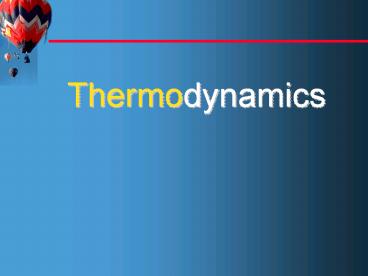Thermodynamics%20Chapter%201 - PowerPoint PPT Presentation
Title:
Thermodynamics%20Chapter%201
Description:
Bomb Calorimeter Used to. Determine Energy Content of Food (Fig. 1 ... where h is the height of the liquid column above the free surface. 1-24. WCB/McGraw-Hill ... – PowerPoint PPT presentation
Number of Views:80
Avg rating:3.0/5.0
Title: Thermodynamics%20Chapter%201
1
Thermodynamics
2
1
CHAPTER
BasicConcepts ofThermodynamics
3
Applications of Thermodynamics
1-1
4
Crossing Closed-System Boundries
1-2
Energy, not mass, crosses closed-system boundries
- (Fig. 1-13)
5
Closed System with Moving Boundry
1-3
6
Crossing Control Volume Boundaries
1-4
Mass and Energy Cross Control Volume Boundaries
7
Systems Internal Energy
1-5
Systems Internal Energy Sum of Microscopic
Energies
- (Fig. 1-19)
8
Quasi-Equilibrium, Work-Producing Devices
1-6
Quasi-Equilibrium, Work-Producing Devices Deliver
the Most Work
- (Fig. 1-30)
9
Compressed Process P-V Diagram
1-7
- (Fig. 1-31)
10
Absolute, Gage, and Vacuum Pressures
1-8
- (Fig. 1-36)
11
The Basic Manometer
1-9
12
Temperature Scales Comparison
1-10
- (Fig. 1-48)
13
Many Ways to Supply the Same Energy
1-11
Ways to supply a room with energy equalling a
300-W electric resistance heater
- (Fig. 1-52)
14
Bomb Calorimeter Used to Determine Energy
Content of Food
1-12
- (Fig. 1-53)
15
Chapter Summary
1-13
- Thermodynamics is the science that primarily
deals with energy.
16
Chapter Summary
1-14
- The first law of thermodynamics is simply an
expression of the conservation of energy
principle, and it asserts that energy is a
thermodynamic property. - The second law of thermodynamics asserts that
energy has quality as well as quantity, and
actual processes occur in the direction of
decreasing quality of energy.
17
Chapter Summary
1-15
- A system of fixed mass is called a closed system,
or control mass, and a system that involves mass
transfer across its boundaries is called an open
system, or control volume.
18
Chapter Summary
1-16
- The mass-dependent properties of a system are
called extensive properties and the others,
intensive properties. Density is mass per unit
volume, and specific volume is volume per unit
mass.
19
Chapter Summary
1-17
- The sum of all forms of energy of a system is
called total energy, which is considered to
consist of internal, kinetic, and potential
energies. Internal energy represents the
molecular energy of a system and may exist in
sensible, latent, chemical, and nuclear forms.
20
Chapter Summary
1-18
- A system is said to be in thermodynamic
equilibrium if it maintains thermal, mechanical,
phase, and chemical equilibrium.
21
Chapter Summary
1-19
- Any change from one state to another is called a
process. - A process with identical end states is called a
cycle.
22
Chapter Summary
1-20
- During a quasi-static or quasi-equilibrium
process, the system remains practically in
equilibrium at all times.
23
Chapter Summary
1-21
- The state of a simple, compressible system is
completely specified by two independent,
intensive properties.
24
Chapter Summary
1-22
- Force per unit area is called pressure, and its
unit is the pascal. The absolute, gage, and
vacuum pressures are related by
25
Chapter Summary
1-23
- Small to moderate pressure differences are
measured by a manometer, and a differential fluid
column of height h corresponds to a pressure
difference of where ? is the fluid density
and g is the local gravitational acceleration.
26
Chapter Summary
1-24
- The atmospheric pressure is measured by a
barometer and is determined from where h is
the height of the liquid column above the free
surface.
27
Chapter Summary
1-25
- The zeroth law of thermodynamics states that two
bodies are in thermal equilibrium if both have
the same temperature reading even if they are not
in contact.
28
Chapter Summary
1-26
- The temperature scales used in the SI and the
English system today are the Celsius scale and
the Fahrenheit scale, respectively.
29
Chapter Summary
1-27
- The absolute temperature scale in the SI is the
Kelvin scale, which is related to the Celsius
scale by
30
Chapter Summary
1-28
- In the English system, the absolute temperature
scale is the Rankine scale, which is related to
the Fahrenheit scale by
31
Chapter Summary
1-29
- The magnitudes of each division of 1 K and 1 0C
are identical, and so are the magnitude of each
division of 1 R and 10F. Therefore,and
32
Chapter Summary
1-30
- An important application area of thermodynamics
is the biological system. Most diets are based on
the simple energy balance the net energy gained
by a person in the form of fat is equal to the
difference between the energy intake from food
and the energy expended by exercise.































